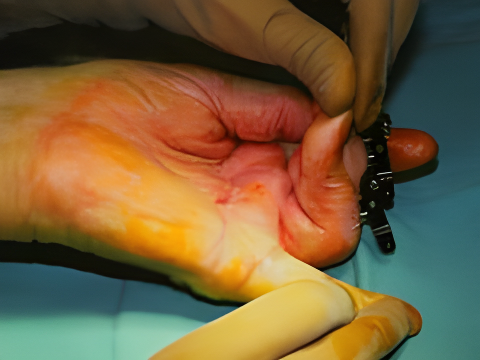What You’ll Learn in This Blog:
● What makes Dupuytren contracture challenging to treat in older adults
● Why traditional treatments often fall short
● How Digit Widget delivered results in 8 weeks
● The key advantages of biomechanical intervention over splints or injections
Struggling with limited hand mobility due to Dupuytren contracture? Discover a treatment that restores function without the pain, trauma, and scarring of an open release.
Millions of people globally suffer from Dupuytren contracture—a hand condition where fingers, most often the ring and little fingers, bend toward the palm. At its core, all PIP (proximal interphalangeal) joint contractures stem from a force imbalance across the joint, causing either too much flexion torque, too little extension torque, or a combination of the two. In the case of Dupuytren, the diseased cord causes too much flexion torque. Over time, this imbalance leads to contractures that often become severe enough to disrupt normal activities of daily living.
A passionate life, interrupted by Dupuytren Contracture
When an active 83-year-old man—an avid golfer and social butterfly—found himself unable to wear gloves, shake hands, or even place his hand in his pocket, his independence began to fade. With Dupuytren contracture severely limiting both his long and ring fingers, even the simple pleasure of driving his golf cart and gripping his clubs became frustrating.
Simple tasks became daily obstacles—buttoning a shirt, holding utensils, or maintaining hygiene grew increasingly difficult. At his age, invasive surgery carried significant risks, and traditional treatments like splints offered little improvement. He needed something better—something more effective.
The limitations of conventional orthopedic treatment
Traditional orthopedic treatment options—splints, injections, or invasive surgeries—come with limitations:
1. Splints put pressure on the skin, causing pain and discomfort after only a few hours, whereas skeletal extension torque should not be painful and can be worn up to 24 hours/day.
2. Splints often fail to stop or reverse the progression in severe cases
3. Injections can cause pain, bruising, scarring, or skin tears
4. Invasive surgery may lead to a long recovery, trauma, or even more scar tissue
5. May limit finger mobility or cause complications that require further intervention

For this patient, the advanced nature of the contracture meant these conventional approaches posed significant risks—either falling short of therapeutic goals or introducing avoidable trauma and downtime.
How did Digit Widget make a difference?
Digit Widget was developed by the late Dr. John Agee, a pioneering orthopedic surgeon whose work continues to restore hand function for patients. Designed to offer a minimally invasive, biomechanical approach to Dupuytren contracture, Digit Widget was created specifically to address severe cases where splints fall short.
For this patient, whose daily life was increasingly limited by the contracture, even simple tasks like washing his hands, buttoning a shirt, or reaching into his pocket had become constant reminders of lost independence. He underwent a release of the palmar bands (without excision), followed immediately by the use of two Digit Widgets.

These lightweight devices applied gentle, continuous extension torque, gradually and painlessly straightening his fingers, and with them, restoring the freedom to move, care for himself, and reengage with life.
In just five weeks, his hands began to open in ways he hadn’t thought possible. His PIP joint angles improved dramatically—from 88/125 to 53/100 in the long finger, and from 108/125 to 73/105 in the ring finger. Tasks that once felt impossible—like slipping on gloves or clasping his hands—were now within reach.
By week eight, the transformation was undeniable. With his range of motion improving to 33/72 (long) and 35/74 (ring) even against the resistance of the Digit Widget elastic bands, he felt ready to reclaim a part of his life he’d deeply missed. He chose to remove the devices
and return to the golf course, gripping his clubs with comfort and confidence for the first time in years.

One month after device removal, his progress held strong: 28/90 in the long finger and 34/92 in the ring. The results weren’t just clinical—they were deeply personal. He had regained not only function but also freedom, dignity, and joy in the everyday moments that define a full life.
Before
After


Ready to reclaim motion without invasive surgery?
Talk to a specialist about how Digit Widget can help
Why does Digit Widget stand out in treating Dupuytren Contracture?
This case is a powerful reminder of what’s possible when treatment goes beyond temporary fixes and addresses the root cause of contracture. For patients with advanced Dupuytren contracture, Digit Widget offers more than just mechanical correction—it restores autonomy, dignity, and the ability to participate fully in life.
Compared to traditional treatments, Digit Widget provides a minimally invasive path to recovery, without the trauma, scarring, or long recovery times associated with open procedures.
Here’s why more surgeons and patients are turning to Digit Widget:
● Fast outpatient treatment for severe contracture, where splints fail
● Less trauma and scarring as are caused by injections or open procedures
● Regain full range of motion and quality of life
● Wear 24/7 comfortably—no blisters or pressure on the skin
● Avoid risks of injections or surgical complications
Don’t wait for contracture to take more away.
Talk to your surgeon about how Digit Widget can help.
Powered by MarketEngine from StartupWind
